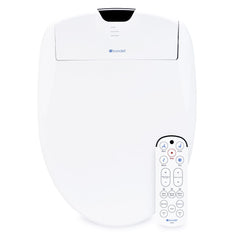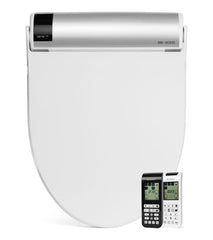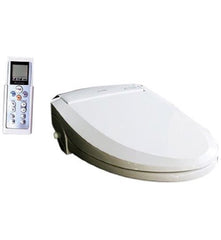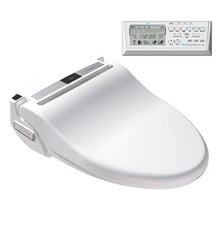Bidet design has seen a number of innovations over the past decade. The traditional big ceramic floor-mounted bidet that looks like a toilet and takes up half the bathroom still exists, but it’s no longer the rule.
Today, two types of bidet are generally available: the ‘traditional’ ceramic (porcelain) bidet, and the more compact, toilet seat bidet.
Floor-mounted bidets in bathrooms have been around since the early 1900s. The elegant look of a floor-mounted porcelain bidet will give any bathroom a touch of class that will never fade. Although this particular type of bidet has changed very little over the years, bidets in general have undergone a number of important modifications.
There are two types of ceramic bidet: floor-mounted, and wall mounted. Floor-mounted bidets, which are more common, come in a variety of styles, from classic and antique, to sleek and contemporary; there’s a bidet style for every bathroom. Wall-mounted bidets – often paired with a wall-mounted toilet – with their exquisite, modern look, bring a sophisticated ambience to modern bathroom design.
Lack of space is the main reason ceramic bidets have not become more popular. Unfortunately, most people’s bathrooms simply aren’t big enough to accommodate two toilet-sized units. You really need a very large bathroom for a full-sized bidet to be practical. Thankfully, for those of us who don’t live in palaces, advances in bidet technology have led to the development of the space-saving, toilet-seat bidet.
In recent years, sales of toilet-seat bidets have risen significantly, even in North America. They are affordable, compact, convenient, and their benefits are unquestionable. Prices range from $30 for a basic unit to $1000 for top-of-the range models – so there’s a bidet for every budget, and even the lowest priced bidets provide exactly the same hygiene benefits.
Toilet-seat bidets also come in two main types: electric bidets, and non-electric bidets.
Non-electric bidets are usually priced at under $100, and they really are great value for money. The most basic units come with one option – a cold water wash. More expensive non-electric toilet-seat bidet models usually have a couple of additional options. One of these is warm water. This will be good news for people don’t want their nether regions to be subjected to an unexpected jet of cold water. Other options for non-electric bidets include a self-cleaning function and a feminine wash. The self-cleaning option enables the user to clean the spray nozzles simply by turning a dial. The feminine wash allows the angle of the spray nozzle to be adjusted to suit the female anatomy. Non-electric bidets were designed to provide an affordable, alternative, eco-friendly method of toilet hygiene – they may not be fancy, but they do work!
Next, we have the electric bidet. These toilet-seat bidets have countless features. Not only can you have warm water, you can also decide how warm you want it. And, speaking of warmth, how about a toilet seat warmer? That’s another great option. From spray pressure, to spray angle, to air dryer, to deodorizer, these bidets have every option imaginable. And, as you’ve probably guessed, the price goes up with the number of options. These electric bidets start from around $250 and go all the way up to (and over) $1000.
One of the lesser known bidets is the hand-held bidet, also called a Shattaf (washer) because of its Middle Eastern origins. The Shattaf is popular in Muslim communities all over the world and is gaining popularity with many non-Muslims too. A hand held bidet is simply a hose with a spray at one end connected to your toilet's water supply. Shattafs are inexpensive, convenient, and very, very easy to install. The advantage of a Shattaf is that, unlike with other non-electric bidets, you have much more control over the spray. The disadvantage, however, is that these bidet sprays are sometimes difficult to position with precision. Although these hand-held bidets may lack the luxury features you get with an electronic bidet, they are no less hygienic.
Last but not least, the portable bidet. The portable bidet is simply a small water bottle-type device with a spout designed for “paper-free” toilet hygiene – often carried by bidet users when travelling abroad, but equally popular for domestic use. Thanks to the wonders of modern technology there’s also the option of a portable electronic bidet with a battery-powered, no-need-to-squeeze, automatic spray. These devices are the ideal solution when there is no regular bidet available, but they’re not very practical for regular use. Most people find the water runs out too quickly, and there’s not enough spray pressure for effective cleaning.
If you’re thinking of investing in a bidet, the first thing you should decide is the type of bidet that will suit your needs and your budget best – a full-sized ceramic bidet or a toilet seat bidet? And, if you’re going for an electric bidet, which options would you prefer? To find out more about the individual features of electric bidets, please visit our bidet buying guide.
If you have any questions about choosing the right bidet for you and your family, please feel free to contact us for a live chat during business hours. Just click the box on the right and a member of our support team will be with you in just a few seconds.





